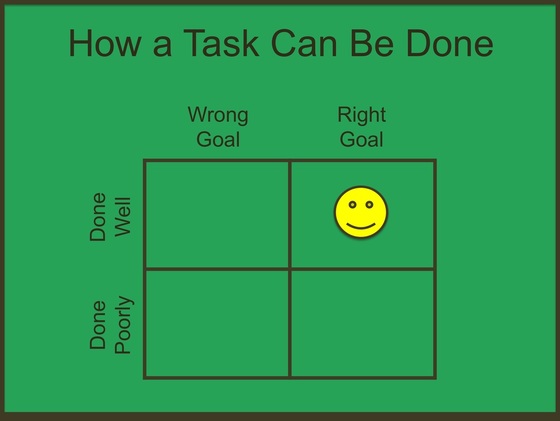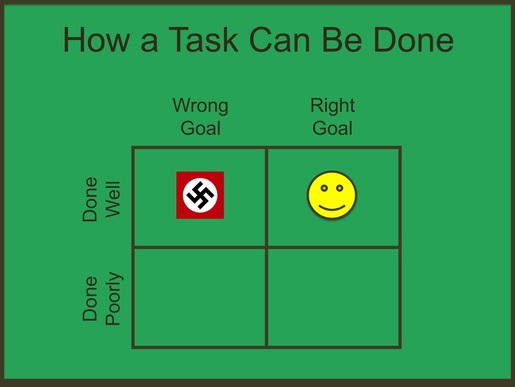---------------------------------------------------
The critics all agreed. The cinematography was breathtaking, the acting first rate, the dialogue crisp, the pacing perfect, and the original score both magnificent in its own right and used expertly in the service of the movie. But they also agreed that De Puta Madre was morally repulsive. The worldview it presented was one in which Hispanics are racially superior to other human beings, cruelty to the old is seen as necessary, and childless women are liable to be raped with impunity.
There the consensus ended. For some, the moral depravity of the film undermined what would otherwise be its strong claims to being a great work of art. For others, the medium and the message needed to be separated. The film was both a great work of cinematic art and a moral disgrace. We can admire it for its former qualities and loathe it for the latter.
The debate was more than academic, for so repugnant was the film's message that it would be banned, unless it could be argued that its artistic merits justified exemption from censorship. The director warned that a ban would be a catastrophe for free artistic expression. Was he right?
Baggini, J., The Pig That Wants to Be Eaten, 2005, p. 142.
---------------------------------------------------
As Baggini admits in his discussion of this experiment, the most obvious real-life example of something like De Puta Madre is Leni Riefenstahl's 1935 Nazi propaganda film Triumph of the Will. That movie: "chronicles the 1934 Nazi Party Congress in Nuremberg, which was attended by more than 700,000 Nazi supporters. The film contains excerpts from speeches given by Nazi leaders at the Congress, including Adolf Hitler, Rudolf Hess, and Julius Streicher, interspersed with footage of massed Sturmabteilung (SA) and Schutzstaffel (SS) troops and public reaction. Hitler commissioned the film and served as an unofficial executive producer; his name appears in the opening titles." The film is still banned in Germany and is shocking to see. I watched it this week in preparation for this blog and the entire movie is available for free on youtube here:
With apologies to Oscar Wilde (who said what he said at a time when society's norms about his homosexuality were deeply immoral), I side with Keats on this issue. As I wrote in my thoughts on aesthetics:
Science is the root method of gathering knowledge. Engineering is knowledge applied to the physical world. Business is knowledge applied to the economic world. Politics is knowledge applied to the realm of government. Medicine is knowledge applied to the body. Art is knowledge applied to the emotions. Science finds knowledge. Art uses knowledge to inspire. (It can also inspire scientists.) Art causes emotional responses so it often draws emotional people to it, but great art is created by rational processes, filled with knowledge, fueled by emotion, and executed with skill. Bad art is blind emotion that purports falsehoods for truth.
Watching The Triumph of the Will, I couldn't help but think it was bad art—blind emotion purporting falsehoods for truth. As is the case for anything complex, Hume's bundle theory explains how we can see various properties of objects separately, so we might indeed be able to take cues from the good craftsmanship of a bad artist, but that doesn't mean the art he or she produces is any good, or even worth looking at except for the historically- or technically-minded student. In this week's thought experiment, De Puta Madre would similarly be judged as bad art. As for the question of its censorship, I wrote this in My Response to Thought Experiment 33: The Free-Speech Booth:
So to me, the limitations of free speech should be held to the higher standard of the harm principle. As distasteful as I find members of the Westboro Baptist Church or the KKK or preachers of Sharia law, I think these people have the right to offend us. Now, our ears should have the right not to hear them, so I don't think these people have the right to shout their beliefs (to be a public nuisance) towards others who are merely trying to go about their daily lives, but if people just want to speak their beliefs or share them in writing, they should be free to do so. I must caveat that, however, by pointing out how the line to harm can easily be crossed. When evangelists of any kind spout provably false claims in the hopes of recruiting members to their cause under false pretenses (which would materially harm their lives), such false speech should be restricted, just as it is within advertising laws. This is how I think a number of European countries that are generally considered strong upholders of freedom of speech can manage to correctly outlaw speech that might be interpreted as Holocaust denial.
Therefore, depending on the historical facts surrounding De Puta Madre and the country it is being considered within, the question of whether it may be banned or not depends on whether or not its message is likely to rise to the level of causing actual harm or only merely offense. The thought experiment stated that "it would be banned, unless it could be argued that its artistic merits justified exemption from censorship," but this is the wrong consideration. No matter how eloquent the message, intentionally threatening harm (e.g. shouting "Fire!" sonorously in six languages) can and should be banned. From the limited information in this week's thought experiment, I think De Puta Madre could be shown, but it would be a flop because it would bore its audience to tears in eye-rolling disbelief.
What do you think? Have you ever loved a movie or a book with a terrible message just because it was skillfully made? What does the obviously evil example of The Triumph of the Wills tell you about less overt or morally ambiguous examples? Can ethics and aesthetics really be united once an ethical stance has been accepted? As a philosopher and artist, I've made my point clear on this, but I wonder what the audience says.



